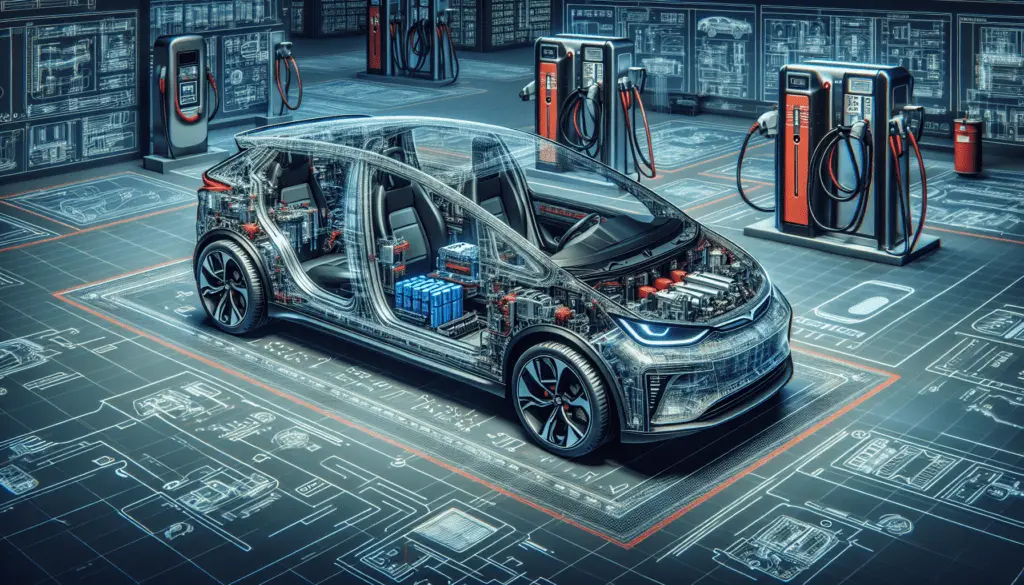In this article, you will discover the fascinating world of technology that powers Ford’s electric vehicles. From advanced batteries to regenerative braking systems, we will explore the innovative features that make these vehicles not only eco-friendly but also efficient and exciting to drive. Get ready to be amazed by the cutting-edge advancements that are revolutionizing the way we think about transportation. So, fasten your seatbelt and prepare to delve into the captivating world of Ford Electric Vehicles.
Battery Technology
Battery Types
When it comes to battery technology, electric vehicles (EVs) rely on rechargeable lithium-ion batteries. These batteries are widely used in the automotive industry due to their high energy density and long cycle life. Lithium-ion batteries consist of two electrodes, an anode (positive electrode) and a cathode (negative electrode), separated by an electrolyte. Within this framework, there are different types of lithium-ion batteries, such as lithium iron phosphate (LiFePO4), lithium nickel cobalt manganese oxide (NMC), and lithium nickel cobalt aluminum oxide (NCA). Each battery type has its own advantages and may be suitable for different vehicle applications.
Battery Capacity
Battery capacity refers to the amount of energy that a battery can store and deliver to power an electric vehicle. Typically measured in kilowatt-hours (kWh), battery capacity determines the driving range of an EV. A higher battery capacity means a longer range.
Battery Management System
To ensure the optimal performance and longevity of the battery, electric vehicles are equipped with a battery management system (BMS). The BMS monitors various parameters of the battery, such as voltage, temperature, and state of charge, to protect it from overcharging, overheating, or over-discharging. The BMS also helps balance the individual cells within the battery pack to maintain uniform performance and maximize battery life.
Electric Motor
Types of Electric Motors
Electric vehicles utilize different types of electric motors for propulsion. The most common type is the alternating current (AC) induction motor, which offers simplicity, reliability, and high torque. Another popular choice is the permanent magnet synchronous motor (PMSM), known for its efficiency and precise control. Additionally, some EVs incorporate a hybrid drivetrain that combines an internal combustion engine with an electric motor. These motors vary in size, power output, and efficiency depending on the vehicle’s requirements.
Motor Power and Torque
The power and torque output of an electric motor determines the vehicle’s acceleration and overall performance. Power is a measure of how quickly the motor can deliver energy, while torque represents the twisting force that generates acceleration. Electric motors offer instant torque delivery, providing quick and smooth acceleration from a standstill. The power and torque characteristics of an electric motor can be optimized through advanced motor control algorithms and transmission systems.
Regenerative Braking
Regenerative braking is a unique feature of electric vehicles that allows the motor to act as a generator and recover energy during deceleration or braking. When the driver releases the accelerator pedal or applies the brakes, the motor switches to generator mode and converts the vehicle’s kinetic energy into electrical energy, which is then stored in the battery for later use. Regenerative braking not only improves the vehicle’s energy efficiency but also helps extend the driving range.

Charging Infrastructure
Types of Charging Stations
Charging infrastructure is crucial for the widespread adoption of electric vehicles. There are different types of charging stations available, ranging from basic Level 1 chargers to high-power Level 3 chargers. Level 1 chargers are the most common and can be plugged into a standard household outlet. They provide a slow charging rate and are suitable for overnight charging. Level 2 chargers offer faster charging times and require a dedicated charging station or outlet, typically found in parking facilities or commercial locations. Level 3 chargers, also known as DC fast chargers, provide rapid charging capabilities and are typically found along highways or in public charging stations.
Charging Speeds
The charging speed of an electric vehicle depends on the charging station’s power output as well as the vehicle’s onboard charger capabilities. Charging speeds are often measured in kilowatts (kW). Level 1 chargers typically have a power output of 1.4 to 2.4 kW, Level 2 chargers range from 3.3 to 22 kW, and Level 3 chargers can exceed 200 kW. Faster charging speeds allow for shorter charging times, enabling EV drivers to conveniently top up their vehicles during longer journeys.
Home Charging Options
Many electric vehicle owners prefer to have a home charging solution for added convenience. Home charging options include Level 1 chargers that can be plugged into a standard electrical outlet, providing slow overnight charging. Alternatively, Level 2 chargers can be installed in a dedicated charging station at home, offering faster charging capabilities. Having a home charging option allows EV owners to start each day with a full battery, eliminating the need for frequent visits to public charging stations.
Range and Efficiency
Maximum Range
The maximum range of an electric vehicle refers to the distance it can travel on a single charge. The range varies depending on factors such as battery capacity, vehicle weight, driving conditions, and efficiency. With advancements in battery technology, some electric vehicles can now achieve ranges of over 300 miles on a single charge. However, it’s important to note that real-world range may differ due to factors such as driving style, weather conditions, and the use of auxiliary systems like air conditioning.
Energy Efficiency
Energy efficiency is a key aspect of electric vehicles as it determines how effectively the available energy from the battery is converted into propulsion. Electric vehicles are inherently more energy-efficient than their internal combustion engine counterparts due to the high efficiency of electric motors and the absence of energy losses related to idling or transmission systems. The efficiency of an electric vehicle can be further improved through advancements in aerodynamics, lightweight materials, and regenerative braking systems.
Factors Affecting Range
Several factors can affect the range of an electric vehicle. Firstly, driving style plays a significant role, as aggressive acceleration and high speeds can deplete the battery faster. Secondly, external factors such as temperature and weather conditions can impact range. Cold weather reduces battery performance and requires additional energy for heating the cabin, while hot weather can affect battery cooling. Lastly, the use of auxiliary systems like air conditioning, lights, and multimedia devices consumes additional energy, reducing the overall range of the vehicle.

Vehicle Platforms
Dedicated Electric Platforms
Dedicated electric platforms are designed from the ground up specifically for electric vehicles. These platforms incorporate the necessary structural elements and components to accommodate electric drivetrains and large battery packs. Dedicated platforms offer several advantages, including optimized weight distribution, enhanced space utilization, and the ability to maximize battery capacity. These platforms also enable automakers to design EVs with unique styling and features, providing a distinct identity for electric vehicles.
Adapting Existing Platforms
Alternatively, existing vehicle platforms can be adapted to accommodate electric drivetrains. This approach allows automakers to leverage their existing production capabilities and infrastructure while incorporating electric powertrains. Adapting existing platforms can be a cost-effective solution, especially for automakers transitioning from internal combustion engines to electric vehicles. However, it may come with challenges such as limited space for battery placement and the need for additional modifications to ensure safety and performance.
User Interface
Digital Dashboard
The user interface of an electric vehicle is often centered around a digital dashboard, which provides drivers with important information about the vehicle’s performance, battery status, and charging information. Digital dashboards can display various customizable metrics such as speed, range, energy consumption, and real-time efficiency data. Additionally, they may offer navigation systems, media controls, and connectivity features to enhance the overall driving experience.
Connectivity Features
Connectivity features in electric vehicles allow for seamless integration with mobile devices and online services. These features enable drivers to remotely monitor and control certain vehicle functions, such as pre-conditioning the cabin temperature or locating nearby charging stations. Connectivity also allows for software updates, ensuring that the vehicle’s operating system and infotainment systems are up to date.
Smartphone Integration
Smartphone integration is another important aspect of the user interface in electric vehicles. This feature allows drivers to connect their smartphones to the vehicle’s infotainment system, providing access to navigation, music streaming, hands-free calling, and voice commands. Smartphone integration enhances convenience and ensures that drivers can stay connected while on the road, without compromising safety.

Safety Features
Crash Safety
Crash safety is a top priority for electric vehicle manufacturers. Electric vehicles are equipped with advanced safety features, including robust body structures, reinforced battery enclosures, and strategically placed crumple zones. These safety features aim to protect the occupants in the event of a collision and to minimize the risk of damage to the battery pack. Additionally, electric vehicles often incorporate advanced driver assistance systems (ADAS) to further enhance safety on the road.
Advanced Driver Assistance Systems
Advanced Driver Assistance Systems (ADAS) utilize various sensors and cameras to assist drivers in avoiding collisions and maintaining safe driving behaviors. These systems can include features such as adaptive cruise control, lane-keeping assist, automatic emergency braking, blind-spot monitoring, and parking assistance. ADAS technologies help reduce the risk of accidents and contribute to overall road safety.
Pedestrian Detection
As part of their commitment to safety, electric vehicles often incorporate Pedestrian Detection systems. These systems use a combination of sensors and cameras to detect pedestrians and other vulnerable road users in the vehicle’s vicinity. In the event of a potential collision, the system can issue warnings to the driver or autonomously apply the brakes to prevent or mitigate the impact. Pedestrian detection systems help enhance the safety of both occupants and pedestrians.
Software and Updates
Operating System
Electric vehicles rely on sophisticated software systems to control various aspects of the vehicle’s operation. The operating system is responsible for managing the motor, battery, charging, regenerative braking, and other critical functions. These software systems are continuously evolving, with updates being released by automakers to improve performance, add new features, and address any software-related issues. A robust and reliable operating system is essential to ensuring the optimal performance and user experience of electric vehicles.
Over-the-Air Updates
One of the advantages of electric vehicles is the ability to receive over-the-air updates, similar to smartphones and computers. Over-the-air updates allow automakers to remotely update the vehicle’s software systems, including the operating system, infotainment system, and connectivity features. This eliminates the need for owners to visit a service center for software updates, providing convenience and ensuring that the vehicle is always running on the latest software version.
App Integration
App integration in electric vehicles allows for seamless integration with mobile applications, enhancing the overall user experience. These apps can provide features such as remote vehicle monitoring, battery status check, charging station locator, trip planning, and vehicle control functions. App integration ensures that drivers can easily access important information and interact with their vehicles from the convenience of their smartphones.

Manufacturing and Supply Chain
Battery Production
The production of batteries for electric vehicles is a significant aspect of the manufacturing process. Battery production involves the assembly of individual battery cells, as well as the integration of battery management systems and thermal management systems. Automakers often collaborate with specialized battery manufacturers or establish their own battery production facilities to ensure a reliable supply of high-quality batteries. The manufacturing process also includes rigorous quality control measures to ensure that the batteries meet safety and performance standards.
Supplier Partnerships
Electric vehicle manufacturers often rely on strategic partnerships with suppliers to ensure a smooth and efficient supply chain. These partnerships involve collaborating with suppliers for components such as electric motors, battery cells, power electronics, and charging infrastructure. By working closely with suppliers, automakers can optimize the design and integration of these components, ensuring that they meet the specific requirements of electric vehicle platforms.
Environmental Sustainability
Environmental sustainability is a key consideration in the manufacturing and supply chain of electric vehicles. Automakers strive to minimize the environmental impact of producing electric vehicles by implementing sustainable practices. This includes reducing energy consumption, minimizing waste generation, utilizing renewable energy sources, and implementing recycling programs for battery components. By prioritizing environmental sustainability throughout the manufacturing and supply chain process, electric vehicle manufacturers can contribute to a greener and more sustainable future.
Warranty and Support
Battery Warranty
Battery warranty is an important aspect for electric vehicle owners. Electric vehicle manufacturers typically offer warranties on the battery pack that cover a certain period of time or mileage. These warranties provide assurance to the owners that the battery will meet performance and reliability standards. The duration and terms of the battery warranty may vary between manufacturers, but it is generally considered a crucial factor in the purchasing decision of an electric vehicle.
Maintenance and Service
Electric vehicles generally require less maintenance compared to internal combustion engine vehicles, as they have fewer moving parts and do not require regular oil changes or tune-ups. However, routine maintenance such as tire rotations, brake inspections, and battery health checks are still important to ensure optimal performance. Electric vehicle owners should follow the manufacturer’s recommended maintenance schedule and seek out authorized service centers or technicians who are trained in servicing electric vehicles.
Support Infrastructure
To provide a positive ownership experience, electric vehicle manufacturers invest in building a robust support infrastructure. This includes establishing a network of authorized service centers equipped with specialized tools and trained technicians to handle electric vehicles’ unique requirements. Additionally, manufacturers may offer roadside assistance programs and provide access to customer support teams to address any concerns or technical issues that owners may encounter.
In conclusion, the technology behind Ford electric vehicles encompasses various aspects, each playing a crucial role in the overall performance, usability, safety, and sustainability of these vehicles. From battery technology and electric motors to charging infrastructure and user interface, Ford has leveraged advancements in technology to deliver efficient, reliable, and feature-rich electric vehicles that cater to the needs and preferences of modern drivers. Furthermore, with a focus on manufacturing, supply chain, warranty, and support, Ford aims to ensure a seamless ownership experience and contribute to a greener and more sustainable future.



